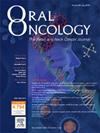Refining prognostic subcategories in intermediate-advanced glottic cancer: A multicentric study on 637 patients treated by transoral laser microsurgery
IF 4
2区 医学
Q1 DENTISTRY, ORAL SURGERY & MEDICINE
引用次数: 0
Abstract
Background
The current TNM staging system does not fully address the variations in glottic squamous cell carcinoma (SCC) extension and subsites involvement, especially if treated with transoral laser microsurgery (TOLMS). This study aims to evaluate the oncologic outcomes after TOLMS in intermediate-advanced glottic SCC, stratified by prognostic subcategories based on anatomical tumor extension.
Methods
This retrospective multicentric study analyzed 637 previously untreated patients with pT2-T3 glottic SCC treated by TOLMS following the same policies at four tertiary European centers. Patients were stratified into 5 subcategories (III, IV, Va, Vb, VI) based on three-dimensional local tumor extension, a refined definition of the previous classification proposed by Piazza et al.
Results
Out of 637 patients, 453 (71 %) were pT2, and 184 (29 %) pT3. The 5-year disease-specific survival for the entire cohort was 91 %, LCL 81 %, and LP 87 %. Subcategories Va (anterior paraglottic space [PGS] involvement) and Vb (posterior PGS involvement) showed significantly poorer disease-specific survival (Va: 91 %, Vb: 80 %) and local control with laser alone (Va: 76 %, Vb: 68 %) compared to subcategories III (tumors extending superficially to the supra- and/or subglottis) and IV (tumors infiltrating the vocal muscle). Tumors with posterior PGS involvement demonstrated the highest risk of local recurrence and total laryngectomy (HR: 3.70).
Conclusion
TOLMS is a viable treatment option for T2-T3 glottic SCC, offering high rates of laryngeal preservation and favorable oncologic outcomes in well-selected patients. Stratification based on tumor subsites involvement provides critical prognostic insights, with posterior PGS invasion serving as a key risk factor for poorer outcomes.
求助全文
约1分钟内获得全文
求助全文
来源期刊

Oral oncology
医学-牙科与口腔外科
CiteScore
8.70
自引率
10.40%
发文量
505
审稿时长
20 days
期刊介绍:
Oral Oncology is an international interdisciplinary journal which publishes high quality original research, clinical trials and review articles, editorials, and commentaries relating to the etiopathogenesis, epidemiology, prevention, clinical features, diagnosis, treatment and management of patients with neoplasms in the head and neck.
Oral Oncology is of interest to head and neck surgeons, radiation and medical oncologists, maxillo-facial surgeons, oto-rhino-laryngologists, plastic surgeons, pathologists, scientists, oral medical specialists, special care dentists, dental care professionals, general dental practitioners, public health physicians, palliative care physicians, nurses, radiologists, radiographers, dieticians, occupational therapists, speech and language therapists, nutritionists, clinical and health psychologists and counselors, professionals in end of life care, as well as others interested in these fields.
 求助内容:
求助内容: 应助结果提醒方式:
应助结果提醒方式:


